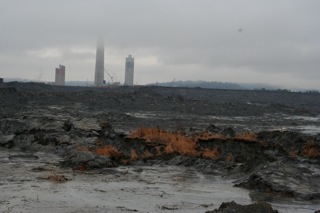
An Unprecedented Disaster
Seven years ago today, an old earthen dam holding back coal ash waste at the Tennessee Valley Authority’s (TVA) Kingston Fossil plant erupted, pouring over one billion gallons of toxic ash sludge into the Emory River and across 300 acres of neighboring property, uprooting trees, and destroying two dozen homes in its path.
The devastation from the disaster was immense. TVA had to purchase around 180 properties that were permanently destroyed by the spill, and more than 60 lawsuits have been filed against TVA representing more than 800 plaintiffs. In August 2012, a U.S. District Judge found TVA negligent and responsible for the disaster due to the location and design of the Kingston plant’s six-story-high coal ash impoundment and the practice of repeated vertical expansions and faulty maintenance, which ultimately caused the failure. Although TVA has already settled about 200 individual legal claims, it will continue to incur legal costs for years to come.
What’s more, 11 workers who were part of the massive dredging and clean-up process have filed a federal lawsuit seeking $55 million in compensatory damages. The workers claim that they have suffered prolonged health issues due to their exposure to toxic coal ash. The lawsuit was filed against Jacobs Engineering Group, which was hired by TVA as the safety contractor for the Kingston clean up. The company allegedly did not allow workers to wear prescribed respirators or even dust masks – even threatening workers with termination if they put on these safety protections. Unfortunately, these workers appear to be another side-effect of the industry’s willful disregard for the dangers posed by exposure to coal ash.
While many people were aware of the coal ash stored at the Kingston Plant, almost no one was prepared for the devastation that a waste pond failure like this could cause. Moreover, Kingston is just one amongst TVA’s fleet of 11 coal plants and approximately 80 in the region. At the time of the Kingston disaster, it was unclear how many more of these plants might have the potential to cause as much devastation as Kingston.
In the Southeast alone there are around 400 known coal ash storage facilities with a total capacity to hold over 118 billion gallons of ash. The Southeast is home to over 50 documented contamination sites where there is known pollution to the ground or surface water. There are also at least 20 “high hazard” coal ash dams in the Southeast, and failure at any one of these dams would be highly likely to inflict loss of life and devastation to communities nearby. This number reminds us how lucky we are that the Kingston disaster happened in the middle of the night in the middle of the winter, rather than on a sunny day when boaters, anglers, and swimmers were out on the Emory River.

7 Years Later, What’s Changed?
In December 2014, originally prompted by the Kingston disaster, EPA released the first-ever minimum standards for storage and handling of coal ash known as the Coal Combustion Residuals rule or coal ash rule. EPA declined to classify coal ash as “hazardous,” meaning that states are not required to implement the rule and the EPA cannot enforce it—leaving enforcement to the utilities themselves, the states, and via citizen suits as a last resort. Despite this missed opportunity to more strongly protect public health and the environment, the coal ash rule places some potentially powerful requirements on utilities that could lead to clean up of particularly dangerous coal ash ponds.
Nearly 7 years after its disastrous spill at Kingston, TVA has finally gone through the permitting process to create permanent storage for its coal ash. Since the disaster, TVA has been storing coal ash at an unlined “temporary” facility on an old ball field on the Kingston site. SACE filed comments on TVA’s permit application and remains concerned about potential weaknesses and dangers in TVA’s plan.
In its efforts to convert to “dry,” permanent storage, TVA is also planning to build a pond to remove water from coal ash (a process known as “dewatering”) so that the coal ash can be dried and stored in an on-site landfill. Unfortunately, as SACE pointed out in our comments, TVA is not planning to use the best technology available, and its plan may pose a serious threat of contamination to ground and surface water. TVA also failed to adequately evaluate an option that could eliminate liquid discharge from Kingston’s bottom coal ash altogether. SACE and our allies called on TVA to release an Environmental Impact Statement which would provide an avenue for the public to learn more about TVA’s plans and to make comments and suggestions. We also urged TVA to evaluate the environmental benefits of fully eliminating liquid discharges from bottom ash that can contaminate ground and surface water.

The Kingston Disaster’s Impact on TN and the Southeast
The Kingston disaster made it clear to utilities, public officials, advocates, and communities that the risk of storing coal ash in unlined impoundments or ponds beside rivers and waterways is unacceptable. Already, Alabama Power and Georgia Power have announced plans to finally address their coal ash pits, in part due to the coal ash rule which was a direct result of the Kingston disaster.
The Tennessee Department of Environment and Conservation (TDEC) also ordered TVA to assess the current status of each of its coal ash sites in Tennessee and address any current contamination. Following this TDEC order, but not necessarily in response, TVA announced it would be taking comments and suggestions on the scope of an upcoming Environmental Impact Statement which will analyze the impacts of closing all TVA’s coal ash units. SACE, along with our allies, submitted comments and suggestions and will continue to track this process as TVA prepares to release a Draft Environmental Impact Statement in the first months of 2016.
As we reflect back on the terrible disaster that occurred 7 years ago today, SACE and our allies continue to call on TVA and all the utilities in the southeast region to get serious about cleaning up their coal ash mess. Utilities need to act aggressively to move coal ash out of unlined, wet storage and to lined, dry storage away from our rivers and waterways.

